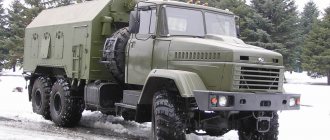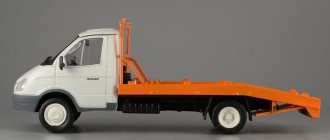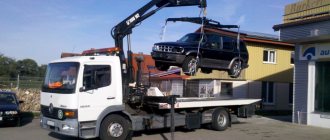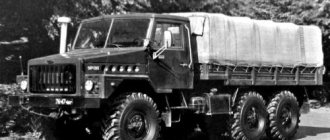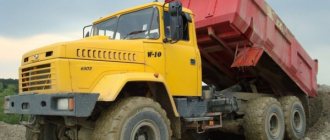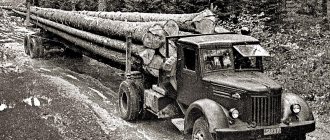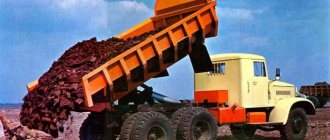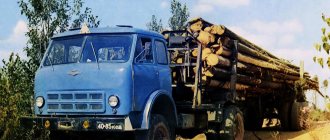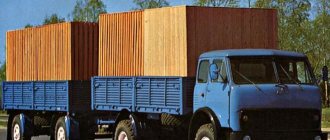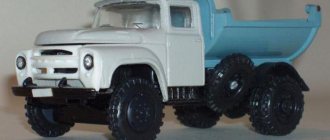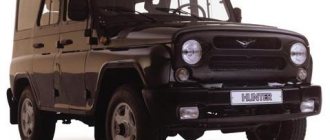Mikhail Sokolov. Photos from the archives of YaMZ OJSC, Alexander Buzdin, author and from the site rcforum.ru
This year marks the 100th anniversary of the Yaroslavl Motor Plant, and in the past - the Automobile Plant, one of the oldest domestic automakers with a rich history. Perhaps its most significant page is the creation and production of the YAZ-210 family of heavy-duty three-axle vehicles. This article is about a rather unconventional and mysterious representative of it - the YAZ-210G ballast tractor.
It would seem, what mysteries could there be? Any reference book that contains information about the YaAZ-210 also mentions its modification 210G. But this is only at first glance. Firstly, if you compare technical literature from different years, it turns out that two different machines are actually hidden under the same index. Secondly, such confusion and so many contradictions in data and descriptions that occur with the YAZ-210G are probably not found in any other domestic model. And thirdly, this car was the only ballast tractor mass-produced in the USSR. In light of all this, let’s try to take a closer look at the history of the car, dispel some myths and, if possible, fill in the numerous “blank spots”.
Omissions...
The YaAZ-210A modification with a universal body and winch, created in parallel with the base model, did not satisfy the main customer, and it was not mass-produced. The fact is that by the end of the 1940s, military doctrine was radically revised: traditional infantry, traveling on trucks or on foot, was replaced by motorized infantry equipped with armored personnel carriers, and the main tactical trucks were 4x4 and 6x6 all-wheel drive vehicles.
The long and clumsy YaAZ-210A with a 6x4 wheel arrangement was not suitable for the role of a heavy multi-purpose army truck. The army leadership turned its attention to the American counterparts from World War II. It seemed logical to create a domestic tank carrier based on the YaAZ-210, i.e. a ballast tractor capable of working with platform trailers for transporting tanks, towing heavy artillery, etc. Therefore, it is not surprising that the version of the three-axle YaAZ with a shortened The 970 mm base under the symbol “210G” received a metal platform copied from the Lend-Lease Diamond (Diamond T-980 / -981).
Another borrowing was a winch with a force of 12 tons, located between the cabin and the platform. As a result, two completely different structurally vehicles (our YaAZ-210G and the American Diamond) turned out to be quite similar in appearance, which gave rise to a very persistent myth about allegedly copying the T-980 / -981 when creating the basic YaAZ-210, which in fact it wasn't even close.
The 210G tractor differed from the flatbed “210” in its reduced base and rear overhang of the frame with a reinforced rear cross member; transfer case (RK) shifted forward by 359 mm; driveshafts shortened by 611 mm from it to the rear bogie and placement of spare wheels in the ballast platform.
In addition, the Republic of Kazakhstan changed the gear ratios: overdrive – from 1.07 to 1.41, and downshift – from 2.13 to 2.28. As a result, the traction properties of the vehicle increased noticeably, but the maximum speed of a single tractor with a load of 8 tons decreased to 45 km/h, and with a trailer weighing 30 tons – to 30 km/h. The winch cable was pulled under the platform not only backwards, but also forwards , where there was a special T-shaped hole on the left side of the bumper. The 1-speed power take-off, which was used to drive the winch, was located on an additional gearbox that was part of the RK and had two gears with straight teeth. In addition, the YaAZ-210G received two towing devices at once - in addition to the rear one, there was also a front one.
The overall dimensions of the early YaAZ-210G were 7375x2650x2570–2595 mm; base – 4080+1400 mm; rear / front wheel track – 1920 / 1950 mm; ground clearance with load – 300 mm; turning radius along the outer wheel track – 10.5 m; approach angles (with load) front / rear – 43° / 55°; internal dimensions, area and volume of the platform – 3076x2640x600 mm, 8.12 m2, 4.9 m3; highest speed – 45 km/h; average fuel consumption with load (8 t + 30 t on trailer) – 140 l / 100 km; total weight without load / with load – 12.36 / 20.585 t; weight distribution along the axles (front axle / rear bogie) without load – 4.47 / 7.89 t; with cargo – 4.335 / 16.25 tons.
And then the oddities and omissions begin. Built at the end of 1948, the first sample 210G was taken into account by statistics only in 1949. In one of the first publications about the car (article by chief designer V.V. Osepchugov, “Automotive Industry” No. 7, 1949) the trailer’s load capacity was limited to only 25 t, not a word was said about the engine power, and about the winch - only with reference to the failed 210A. But in another of his articles (“Automobile” No. 5, 1949) it was stated that the YAZ-210G could tow a trailer with a carrying capacity of up to 45 tons or a total weight of up to 54 tons, and the power of the YAZ-210G engine (as well as the “saddle bar” YaAZ-210D) reached 215 hp, and the diesel engine itself was called “boosted”, but information about the winch was completely absent.
In the book “Three-axle YaAZ cars. Care instructions" (1952) there are even more interesting nuances. In the given technical specifications, in the “engine power” column for the YaAZ-210G it is clearly indicated: 200 hp, but with an asterisk. The footnote below it reads: “On cars currently produced, engines with a power of 165 hp are installed.” The trailer's load capacity is indicated as 40 tons on the highway and 25 tons on the ground. And at the end of the publication, in the list of noted typos, the following appears: it is written - “equipped with a winch”, it should be read - “a winch is designed”. That is, by September 1952 (deadline for going to press), the mysterious winch from the YaAZ-210G design disappears, and only the possibility of its installation remains, and a very illusory one at that. The same data, without any footnotes and notes, can be gleaned from A.D. Abramovich’s reference book “Operational and technical characteristics of domestic cars” (1954).
Despite this, in the magazine “Technology for Youth” (No. 1, 1954) in the article “Tractor”, with the same trailer load capacity (40 / 25 tons), the power of the YaAZ-210G engine is still declared at 200 hp . And finally, perhaps, in the latest reference book, where this particular version of the car is discussed, the “Quick Automotive Reference Book” (NIIAT, 1958), the trailer’s load capacity “falls” to 30/15 tons, and power to 165 hp . And at the same time, in these last two descriptions the notorious winch is invariably present.
YaAZ-210 (1948-1958)
YaAZ-210
(1948-1958)
The first samples of the heavy three-axle flatbed vehicle YaAZ-210 (6x4) were built in April 1948 using the design of American Lend-Lease trucks and tractors (Diamond T). After the transfer of production of YaAZ-200 vehicles to Minsk, the Yaroslavl plant began to work closely on finalizing its heavy three-axle family, the production of which began in 1950. The basic 12-ton flatbed truck YaAZ-210 was equipped with a 6-cylinder two-stroke diesel engine YaAZ-206 (6.97 l, 165 hp), similar to the American prototype “GMC 6-71” and weighing 1060 kg. In terms of its general design, the car did not differ from its predecessor YaAZ-200, but was additionally equipped with a two-stage gearbox, individual cardan drives of both rear axles with double main gears and a center differential, which was equipped with a forced mechanical locking system for the first time in the USSR. The previous cabin received a metal lining, which gave rise to calling it all-metal. The side platform, 5770 mm long, had a metal floor and was equipped with wooden two-section folding side boards connected by a chain. Surprisingly, no devices were provided to make the work of the driver of this 23.5-ton machine easier. The wheelbase of the car was 5050+1400 mm, ground clearance under the bridges was 290 mm. It reached a maximum speed of 55 km/h and consumed from 60 to 80 liters of fuel per 100 km. Since 1955, a 12-ton flatbed version of the YaAZ-210A with an all-metal cargo platform and a mechanical winch behind the cabin, which, in the version with an awning, high lattice sides and longitudinal benches, played the role of a heavy army transport vehicle-tractor. It had a curb weight of 11,840 kg and could tow a 15-tonne trailer.
Army flatbed truck tractor YaAZ-210A with a 165-horsepower diesel engine and a winch. 1955
In the early 1950s, the most capacious 6-meter sealed frame-metal bodies of the SN for the installation of field repair shops in them. Since 1951, the most famous were the first 10-ton diesel-electric truck cranes K-104 of the Odessa plant with a boom length of 10 - 16 m, which were used in the construction of various military and civilian facilities, as well as for reloading heavy missile equipment. To carry out loading and unloading operations during the repair of armored vehicles in the field, a 12-ton K-121 made in Odessa was used. In 1952, on the YaAZ-210 chassis, a prototype of the first Soviet automobile rocket launcher 8U25 , which turned out to be more mobile than the first tracked version 8U220. In 1955 - 1956, these machines were used to install the first Soviet medium-range ballistic nuclear missile R-5 designed by S.P. Korolev from a towed ground lifting and transport cart onto the launch pad. The installer and the cart were docked to the launch table from different sides. A powerful winch and a hydraulically driven portal reloading mast were mounted on the vehicle chassis. When the mast was brought into a vertical position by means of a cable system through the boom blocks using a winch, the rear part of the trolley was lifted into a vertical position and the rocket weighing 28.6 tons attached to it was docked to the launch pad. To protect it from tipping over, the cart was equipped with a kind of balancing device, where a heavy concrete cube played the role of a load. It was suspended on a cable, which at one end pulled back the cart chassis, and at the other it was attached to an anchor concreted into the ground. The rocket installation time took two hours. In 1957, this installer was used to mount the R-5M and R-12 missiles, and then served as the basis for the new 8U210 design with a single-axle tractor.
Frame metal body of the SN series for repair shops on the YaAZ-210 chassis.
The YAZ-210E multi-purpose 10-ton dump truck with a tilt-back body with a capacity of 8 cubic meters was for the first time equipped with a protective canopy over the driver's cabin and was used in military construction or for engineering work. Of the entire 210 series, the YaAZ-210D truck tractor, the YaAZ-210G ballast tractor and the YaAZ-214 special all-wheel drive army truck were the most widely used among the troops, and in 1957 the YaAZ-210 truck was replaced for a short time by the new YaAZ-219 vehicle.
YaAZ-210D truck tractor for towing heavy semi-trailers and artillery systems. 1951
YaAZ-210D (1951 - 1958) - the first Soviet heavy dual-purpose truck tractor on a shortened YaAZ-210 chassis (4080+1400 mm) for towing semi-trailers or artillery systems with a total weight of up to 30 tons and work as part of all-terrain road trains weighing up to 50 t. It was equipped with a hitch with an automatic lock of the fifth wheel and a compressed air extraction system to drive the brake system of the semi-trailer. In conjunction with it, a multi-purpose low-bed 20-ton two-axle semi-trailer MAZ-5203 with a welded frame, rear gable wheels from the YAZ-200 model and two rear folding ramps for loading and unloading heavy self-propelled equipment usually worked in conjunction with it. When installing a dolly under the coupling device, it turned into a three-axle trailer, which was towed by a YaAZ-210G tractor. At large civil and military airfields, YaAZ-210D tractors were used to tow the airfield semi-trailer tanker TZ-16 with a capacity of 16 thousand liters, developed in 1952 by the Zhdanovsky Heavy Engineering Plant, which was followed by special semi-trailer tankers for R-5 missiles.
Ballast tractor YaAZ-210G with a low-sided multi-purpose body without a winch. 1951
YAZ-210G (1951 - 1958) - the first Soviet multi-purpose ballast tractor on a 165-horsepower YAZ-210 truck chassis with a short wheelbase. Its direct prototype was the American version of the Diamond T-981. Rare in the domestic automotive industry, the YaAZ-210G is considered the first Soviet special tank carrier, that is, a means of transporting tanks, tracked armored vehicles and heavy military equipment on a special low-loader trailer on public roads. Behind the cabin there was a welded all-metal platform-box 3400 mm long with smooth sides, handrails and a folding or fixed tailgate, into which up to 8 tons of ballast were loaded - all kinds of stones, bricks or cast iron ingots. By artificially increasing the weight of the vehicle, a significant increase in its traction and traction qualities was achieved, making it possible to tow trailers and artillery systems with a total weight of up to 45 tons on the highway at a speed of 45 km/h, and on the ground - up to 25 tons. At the same time, fuel consumption reached 140 liters per 100 km. The curb weight of a single tractor was 12,360 kg, the total weight of the road train reached 60 tons. To move heavy ballast or pull non-self-propelled loads onto the trailer, a drum winch installed behind the cabin with a cable output forward or backward was used, and two spare wheels were stored vertically at the front side inside the body or on its back side. Special lifting devices were used for their installation and dismantling. The capacity of two fuel tanks reached 510 liters. At military parades, YaAZ-210G tractors towed heavy artillery pieces, and 12 combat crew members were placed inside a steel body on four transverse wooden benches. In the second version, the tractor was equipped with a low-sided metal body with extendable wooden lattice sides, an awning and longitudinal folding seats for transporting crews of towed systems. It usually did not have a winch, so the spare tires were located between the cab and the cargo bed. YaAZ-210G tractors worked mainly in conjunction with a three-axle 20-ton MAZ-5203 trailer with a dolly, which was converted into a semi-trailer, or with a three-axle low-loader 40-ton MAZ-5208 trailer for transporting armored vehicles. The last version had all the gable wheels from the ZIL-164, including eight wheels on the front swivel bogie.
YaAZ-219 (1957 - 1959) is a second-generation multi-purpose 12-ton onboard vehicle, which was the result of the modernization of the entire production range of the Yaroslavl Automobile Plant carried out at the end of 1957. In fact, it was a modified version of the YaAZ-210 model with a new, more spacious and 335 mm wider cabin with a heater and windshield defroster, a flat radiator trim, a new wing shape, increased reliability of the braking system and easier control. The main technical innovations were the 180-horsepower YaAZ-206A diesel engine with an increased compression ratio, two preheaters and a pneumatic power steering mechanism, although by that time it was already installed on the YaAZ-214 army truck. The curb weight of the car was 11,300 kg, the maximum speed remained at 55 km/h, and fuel consumption was reduced to 55 liters per 100 km. Despite the very short production period, the vehicle was put into service and became the main heavy base for promising weapons systems, engineering equipment, tankers and ground support for missile systems. The YaAZ-221 the YaAZ-222 construction dump truck , unified with it, also entered service . These cars received further development after the transfer of production to the Kremenchug Automobile Plant, when a range of heavy-duty superstructures was developed for them.
...and real opportunities
Let's bring some clarity to this confusion. The experimental YaAZ-210G, built by the end of 1948, was indeed equipped with a forced version of the diesel engine, but the American GMC-6-71 with a power of 200 hp. (its copy on a tractor, it seems, actually produced up to 215 hp), since at that moment even the standard YaAZ-206 diesel engine in Yaroslavl was just being mastered, and there was no talk of boosting it at all. However, due to the lack of such diesel engines, starting in 1951, serial tractors had to install the usual 165-horsepower YaAZ-206, which forced the load capacity to decrease.
This did not affect the own load of 210G (8 tons of cargo or ballast), but the load capacity of the towed trailer, depending on the road surface (highway / dirt), had to be reduced to 40 / 25 tons, and then completely to 30 / 15 tons. Although it should be noted that these are relative values, because the trailer’s own weight could fluctuate significantly and significantly affect the operation of the tractor. This is where the considerable scattering of data on the 210G load capacity comes from.
And finally, the winch. The fact is that early YAZ-210Gs were equipped with imported American winches, and when their supply was exhausted in 1952, the winches were simply abandoned. There was no difficulty in their development by domestic industry, but here, too, the decisive factor was the purpose.
In military use, such winches were intended for dragging damaged armored vehicles onto towed low-bed trailers. However, due to the limitation of the total weight of such trailers, the YAZ-210G could only transport light tanks and self-propelled guns, since medium and heavy tanks then already significantly exceeded its permissible weight. Another area of application for traction winches on tractors was the separate overcoming of particularly difficult areas (first a car, then a trailer) or self-pulling of a car. However, the all-wheel drive “ballast” was not quite suitable for these purposes either. Therefore, already in 1952, the YaAZ-210G samples provided for State testing had metal boxes behind the cabs instead of winches. However, this was practically not reflected in the reference literature. If the absence of winches on the 210G since 1952 was occasionally voiced, then the load capacity parameters, and often the engine power in the reference books, were still reprinted from the data of the prototype, and the total weight of the towed trailer was, as a rule, kept silent.
It is interesting that the first production YaAZ-210G with winches took part in the military parade on Red Square on May 1, 1951. At least 8 vehicles then drove out onto the cobblestones of the main square of the country from Istorichesky Proezd, and at least 2 more mandatory spare copies were parked somewhere. then nearby. Perhaps there were even 3 “doubles”, since in total 11 copies of the 210G were produced in 1951, and it seems that all of them were made specifically for this event. Their distinctive features, besides the winches, were long slits in the hood sides and the absence of ventilation hatches on the sides of the dashboard. But the most interesting thing is that these firstborns were not used as “ballast carriers” at all, but as ordinary artillery tractors, for towing 152-mm D-1 howitzers of the 1943 model (total weight 3.6 tons, crew 8 people), although for For this purpose, they could easily get by with the three-axle ZIS-151 already available in sufficient quantities, the permissible weight of the towed trailer of which corresponded exactly to this.
Such a frivolous use of 210G for those in the know looked like “shooting cannons at sparrows,” but it seems that at that moment the organizers of the May Day show had nothing else to do. The tanks moved under their own power; it was not customary to transport them on platforms, but this was the only way to demonstrate the operation of the 210G as a tank carrier. And what kind of tanks could these YaAZ trucks transport? Perhaps the T-34-76 of the 1941-1942 model, since even the T-34-85 had a combat weight exceeding 30 tons. Missiles? But the first domestic ballistic missiles were still under development, and, being top secret, were not subject to any demonstrations. So it turned out that there was simply nothing to properly demonstrate the capabilities of the first domestic “ballasters”, so they limited themselves to only demonstrating them themselves. Moreover, a year later, heavy artillery at parades began to be towed by tracked tractors, and 210G no longer appeared on Red Square.
Subsequently, early YaAZ-210G with winches were still tried to be used in the nascent Strategic Missile Forces for towing ballistic missiles. In particular, in the Pobeda missile system with the R-5 missile (product 8A62), developed in 1951–1953. In this case, 210G winches could be used to lift transport carts with attached missiles onto the launch pad. Subsequently, the 210G was routinely used as a tractor in the 8K51 missile system, but for lifting to the launch pad, special 8U25 missile installers began to be used here. In addition to the missile forces, there was also a need for powerful tractors with heavy-duty trailers in repair and evacuation units, although their number in the army in peacetime was minimal. And, perhaps, the only area where the YaAZ-210G turned out to be indispensable is military and then civil aviation. Here Yaroslavl tractors were used as towing vehicles for heavy bombers, military transport aircraft, and later large passenger airliners. The YAZ-210G could tow aircraft with a total weight of up to 50 tons along the concrete paths of airfields, and with overload - even up to 100 tons (!), and in addition performed other related work (they were equipped with UPG installations for checking hydraulic systems, etc.). But even in aviation, 210G was not required in large quantities.
From all that has been said, it becomes clear that in the form in which it was ordered and designed, the YaAZ-210G was no longer very suitable for the military: its winch was not of decisive importance, and the platform turned out to be small and inconvenient, while between it and the cabin there was an unused space 930 mm long. Much more relevant for the army would be a “ballast tank” with a universal onboard platform, on which the crew of the towed product, ammunition, spare parts, etc. could be placed.
New option
Therefore, already in 1953, at YAZ, starting from the platform of the unclaimed YAZ-210A, they created a new version of the universal multi-purpose platform, which was assigned its own index YAZ-217. The new all-metal cargo-passenger body had low, non-folding sides (with the exception of the rear), in which the upper extension sides of the wooden-metal structure were fixed. As needed, their side sections could be transformed into benches to accommodate people. An awning could be pulled over 5 metal arches installed on top, protecting the cargo and people from bad weather. And the space behind the cab is now occupied by two spare wheels in original holders. Although these design changes did not affect the vehicle index in any way, they also entailed some amendments to the technical specifications: with the same length, the width increased to 2700–2750 mm, and the height with an awning - to 3100 mm; the internal dimensions of the new platform were 3400x2500x355 / 935 mm, loading height - 1575 mm, and area - 8.5 m2.
After the factory tests of the updated 210G, military tests followed, according to the results of which the tractor was characterized as generally satisfying the requirements for it and, taking into account the elimination of some comments, it was recommended for mass production. During the modification, the late production 210Gs had protective headlight grilles on the wings, and by 1955 the PF-3 sidelights were replaced by the PF-10Zh and moved to the wheel parts of the wings. At the same time, the tractor received UP-5 rear direction indicators, and the FP-1A rear light was replaced with the more advanced FP-13.
Since the new version of the YAZ-210G was also intended for the army, information about it, starting from 1955, appeared only in military-technical literature, and in general, the late 210G appeared in few public publications (except for factory ones). However, the serial production of all representatives of this model turned out to be extremely small. In total, from 1951 to 1958, 2302 copies of serial YAZ-210G of both variants came out of the YAZ gates, and by year their production looked like this: 1951 - 11, 1952 - 81, 1953 - 396, 1954 - 388, 1955 - 552, 1956 - 621, 1957 - 202, 1958 - 51. The number of 210G produced was limited not only due to the small production capabilities of the Yaroslavl Automobile Plant, but also as the scope of these applications repeatedly changed tractors in the army. It just so happened that each time this execution was considerably “delayed” by the time it appeared and no longer fit the rapidly changing requirements of the military.
Indeed, during the period from 1948 to 1958, the technical equipment of the Soviet Army made a huge leap forward, completely changing priorities; Entire types of troops have become a thing of the past, and, on the contrary, new ones have appeared that were never heard of before; Tactics, strategy, methods of combat, requirements for military equipment, etc. have changed dramatically. Therefore, often what was a formidable weapon in the late 1940s dropped to an auxiliary level by the mid-1950s.
Thus, both the ballast tractor-tank carrier and the multi-purpose ballast tractor were consistently out of work. By the time the latter appeared, towing heavy artillery guns had already been thoroughly assigned to powerful tracked tractors, so basically the late YaAZ-210G towed transport carts, missile installers, refueling tanks and other equipment along the concrete pads of the Strategic Missile Forces launch complexes. However, in this area too, he was pressed from all sides: the well-proven 210D truck tractors, the YAZ-214 all-wheel drive tractors that had already begun production, and the much more powerful MAZ-535 multi-axle tractors “looming” on the horizon, etc.
By the way, with the arrival of the later 210G models with universal platforms into military units, copies of the early “ballast tanks” began to be sent to the national economy, where they began to be successfully used for transporting especially large indivisible cargo on heavy trailers (powerful transformers for hydroelectric power stations, river vessels, industrial equipment etc.). An urgent need for such tractors arose in the 1950s in the construction industry, when the construction of large industrial facilities and large-scale housing construction began. To transport a tower crane to a new location or tow a heavy pneumatic wheel crane, excavator, etc., a ballast tractor was simply irreplaceable.
In this area, the YaAZ-210G had neither competitors nor a subsequent equivalent replacement. In this regard, it does not at all seem absurd to include the early version of the YAZ-210G in the civilian technical literature of the second half of the 1950s, i.e., at the time when the car was already out of production. Almost all books on the organization of road transport and road reference books of the MAT of the period 1955–1960. contain information exclusively about the early YAZ-210G (most of which had already been transferred to the national economy).
If in the military literature in those years the later version of the tractor with a universal platform was firmly established, then for automobile enterprises and other civilian organizations the description of the early 210G was much more logical and necessary. Even the mention of winches in this case was not an anachronism, since they were necessary for loading and unloading onto a trailer, and often the fleets themselves installed them on tractors that were not originally equipped with them.
This was practiced, in particular, in the 9th motor depot of the Intercity Transportation Directorate of Glavmosavtotrans, in the Leningrad heavy truck motor depot, etc. And these vehicles served for quite a long time. Let's say, newsreel footage has been preserved in which in December 1968 an early YAZ-210G, already thoroughly redesigned, is towing the first prototype of the supersonic Tu-144 aircraft (board number 68001) weighing about 100 tons from the hangar to the runway.
YaAZ, KrAZ and two-stroke diesel engines: post-war heavy vehicles for the Soviet army
Since its founding in the 20s, the Yaroslavl Automobile Plant (YAZ) was never able to get out of the quagmire of manufacturing its previously archaic trucks, but during the Great Patriotic War it managed to launch the production of diesel engines and heavy trucks, which soon had to be transferred to a combine plant in Ukrainian city of Kremenchug.
Military trucks of the Yaroslavl Automobile Plant
The position of YaAZ began to change radically at the end of 1944, when the installation of equipment for the production of two-stroke diesel engines of the GMC Corporation began in new workshops. In 1945, their own prototypes appeared with a three-dimensional figurine of a Yaroslavl bear on the hood. With the engine shop ready, their assembly began in 1947.
One of the prototypes of the YaAZ-200 diesel truck. 1945
YaAZ-200 family (1945-1950)
On board a seven-ton YAZ-200
installed their own four-cylinder diesel engine with a power of 110 hp.
and a wooden cabin. In 1949, it passed military tests and was then used in transport operations, towing artillery systems and participating in parades. YaAZ-205
dump trucks were built on its chassis
YaAZ-200V
truck tractors was produced .
Pre-production road truck YAZ-200 with a 110-horsepower diesel engine.
1947 Despite the short period of production of these machines, they managed to create the first airfield fuel tanker BZ-200
and a five-ton
K-51
to perform engineering work.
Airfield fuel tanker BZ-200 with a tank capacity of 7800 liters on a YAZ-200 chassis. 1948
Multi-purpose five-ton mechanical truck crane K-51 “Yanvarets” on the YaAZ-200 chassis.
1949 YaAZ-210 family and its military versions (1948–1958)
In April 1948, prototypes of the 12-ton YaAZ-210
with rear gable drive wheels and a simplified cabin with door lining made of wooden slats.
A prototype of a three-axle YaAZ-210 truck with a wooden cabin.
1948 (archive of 21 NIITs) The serial version was equipped with a six-cylinder diesel engine with 165 horsepower, individual rear axle drives and an all-metal cabin. In its basic version, it entered the Soviet army, where it delivered heavy loads and served as artillery tractors.
Testing of a YaAZ-210 truck with a 165-horsepower diesel engine, weighing more than one ton. 1949
The YAZ-210A truck was assembled in small quantities
with a low loading platform and a drum winch behind the cab. In addition to cargo operations, it played the role of a heavy transporter-tractor for towing 15-ton guns or trailers.
Special truck YaAZ-210A with a metal body 5.3 meters long and a central winch.
1949 In 1951, the largest experimental frame-metal “big high” BV
for repair shops with multiple side windows.
K-104
and 12-ton
K-121
were installed on the same base .
The largest inhabited military BV body-van for field workshops.
1951 The first heavy 215-horsepower truck tractor YaAZ-210D
on a shortened chassis, the YaAZ-210 was used to tow semi-trailers and artillery systems with a total weight of up to 30 tons. Its features were the selection of compressed air for the brakes of the trailer train and a winch behind the driver's cab, which could be replaced with two spare wheels.
YaAZ-210D tractor with a wooden cabin trim and a winch behind the driver’s cab. 1951
The second version of the YaAZ-210D truck tractor with two spare wheels instead of a winch.
1953 In the army, the main towed means for the YaAZ-210D were the BZ-16
and
TZ-16
with steel elliptical tanks with a capacity of 16 thousand liters of fuel and autonomous engines from Pobeda M-20 to drive pumps.
Road train with a YaAZ-210D tractor and a TZ-16 refueling tank.
1952 (archive of 21 NIITs) Since 1951, the plant has produced the YAZ-210G
with diesel engines with a power of 165 or 215 hp, the direct ideological prototype of which is considered to be the American version of the Diamond T-981. In the first version, the tractor used a welded body with smooth sides, into which up to eight tons of ballast was loaded to improve the vehicle’s traction and traction qualities, which made it possible to tow trailers weighing up to 30 tons. In the second version, a low-sided metal body with extension sides, an awning and longitudinal benches for 12 combat crew members was mounted on it.
YaAZ-210G tractor with a metal ballast body and a centrally located winch. 1951
Army tractor YaAZ-210G with a high-sided body version without a winch.
1954 (archive 21 NIITs) Military truck YaAZ-214 (1951/1956-1959)
A prototype of the YaAZ-214 all-wheel drive truck with rear dual-slope wheels. 1951
This seven-ton truck became the first all-wheel drive diesel vehicle of the Soviet army. Its prototypes on the YaAZ-210 chassis were assembled in the early 50s, and only in 1956 it was possible to begin mass production of the YaAZ-214
with a 205 hp engine, pneumatic power steering, all single wheels and a body with longitudinal benches for 18 personnel.
Serial diesel truck YAZ-214 with all-terrain single wheels.
1958 Military equipment on the YaAZ-214 chassis
For special purposes, a secret marking system for the 214Sh special chassis was developed. For example, the YaAZ-214Sh-7
served for testing advanced missile weapons systems and was equipped with special devices and power take-off shafts for driving superstructures.
Special vehicle YAZ-214SH-7 for transporting and testing heavy military systems and weapons.
1958 According to military orders, in single samples, YaAZ assembled fifth-wheel versions of the YaAZ-214 with a fifth wheel from the MAZ-200V tractor, and the Moscow region military plant No. 38 assembled the KT-214-40P
with synchronous control of the wheels of a semi-trailer, which was planned to be used for the delivery and installation of missile weapons.
Road train KT-214-40P with a YaAZ-214 truck tractor and a semi-trailer with all steerable wheels.
1961 The most famous was the most powerful Soviet multiple launch rocket system at that time, BMD-25.
or a 2P5 launcher for the Korshun tactical missile system with spiral guides for six 250 mm caliber missiles with a range of 55 kilometers.
BMD-25 missile launchers of the Korshun complex at a military parade in Moscow.
1959 Automotive production in Yaroslavl did not last long: at the end of 1959 it was completely transferred to the Kremenchug Automobile Plant (KrAZ), and YaAZ switched to the production of diesel engines. By that time, 1265 YAZ-214 vehicles had been assembled, which in Kremenchug received the KrAZ-214 brand.
Military trucks KrAZ-214 (1959–1967)
The second-generation trucks of the 214th series rolled off the KrAZ assembly line in December 1959 and were no different from their Yaroslavl predecessor, except for the strengthening of the frame side members. Since 1963, the plant has produced the most common version, 214B.
with reinforced front axle and telescopic hydraulic shock absorbers.
Option 214M
had shielded electrical equipment.
Testing of the export version of the KrAZ-214B vehicle for crossing a small river in Germany
Military equipment on the KrAZ-214 chassis
The category of radio communications equipment based on the KrAZ-214M included only radar altimeters of the “Naklon” series for direction finding of low-flying air targets. AKTS-4-214M tank truck was included in the missile systems support section
with a capacity of 4000 liters of acid melange - one of the components of rocket fuel.
Special shielded tank truck AKTS-4-214M for delivery of rocket fuel elements
Engineering and combat vehicles
In the 50-60s, several types of military single-bucket excavators of the E-305
with operator cabins on a rotating platform and auxiliary diesel engines with a power of up to 48 horsepower. They were usually used for the construction of fortifications, shelters and pits, as well as for lifting loads weighing up to four tons.
Mechanical excavator E-305B with a sealed working cabin in the People's Army of the GDR.
1961 Engineering work on frozen sandy and clayey soils was provided by the MZS-13
by screwing piles to a depth of up to eight meters, the screw blades of which cut through the soil without destroying its structure.
MZS-13 machine for drilling wells using steel or plastic blades with a diameter of up to 1.2 meters
Since 1963, the first heavy mechanized bridges TMM
with two folding double-track bridge blocks for establishing crossings with a carriageway width of about four meters.
TMM bridge machine with folded sections in the Leningrad Artillery Museum (photo by the author)
One set of TMM consisted of four bridge laying machines with hydraulic and cable-block drives of the actuators and was used for the construction of crossings up to 40 meters long through shallow water obstacles, ravines and ditches.
Deployment of TMM double-track mechanized bridge blocks in the armed forces of the GDR. 1963
At the same time, testing of the PMP
, which was the first in the world to use sealed folding modular ferries. It consisted of 32 KrAZ-214 trucks for transporting bridge elements. When they brake sharply while reversing at the edge of reservoirs, they were dropped to the surface of the water and automatically opened, forming floating bridges up to 230 meters long and a carriageway eight meters wide.
Modular folding link of the PMP pontoon-bridge park in the artillery museum (photo by the author)
BMD-25 launchers
complex "Korshun", which did not satisfy the military in terms of hit accuracy. So in 1960, all work on them had to be stopped.
Combat multiple launch rocket system BMD-25 of the Korshun complex on KrAZ-214 trucks.
1960 Options and military equipment of the KrAZ-219 truck (1959–1965)
KrAZ-219 truck continued
with a 180-horsepower diesel engine, developed in Yaroslavl to replace the YaAZ-210.
Since 1963, the 219B
with a modified engine was produced.
The KrAZ-221
and
221B
truck tractors were based on these chassis for towing semi-trailer systems weighing up to 30 tons.
The KrAZ-219 heavy multi-purpose truck is the heir to Yaroslavl designs.
1959 , the AKDS-70M oxygen production station was created on the KrAZ-219P special chassis
for obtaining liquid and gaseous oxygen and nitrogen from air. It was housed in two vehicles with frame-metal vans to accommodate process and compressor equipment.
The most widely used tractors were KrAZ-221/221B, working with semi-trailer airfield tankers TZ-22
with tanks for 22 thousand liters of aviation kerosene, autonomous pumping stations and rear control cabins.
KrAZ-221B truck tractor with a TZ-22 two-axle semi-trailer for mechanized refueling of aircraft.
Since 1959, a 10-ton K-104
, which was soon replaced by the 16-ton multi-purpose version
K-162
. Both served in the missile forces, where they were used to load heavy missile equipment at launch sites.
Diesel-electric truck crane K-162 with the drive of working equipment from four electric motors.
The title photo shows a rare 250-mm launcher of the Korshun tactical complex on the YaAZ-214 chassis on display at the Military Historical Museum of Artillery, Engineering Troops and Signal Corps in St. Petersburg.
Source
Late version
Well, what about the later YaAZ-210G? They tried to use them as an army transport truck (8 tons of cargo on any off-road) - it was not entirely successful, due to the lack of a front drive axle; as an auxiliary transport unit; as a training vehicle, etc. But basically it all came down to occasional transportation of heavy indivisible cargo. Although in this traditional incarnation, the late 210G still managed to play a very important and responsible role, not only in the country’s defense capability, but even in the alignment of military-political forces throughout the world. We are talking about the participation of these tractors in the transportation of high-power nuclear warheads. The peak of this role of the YaAZ-210G was the transportation with its help in October 1961 of the most powerful explosive device ever created on the planet - the thermonuclear 58-megaton bomb AN602.
And yet, although this application of 210G was brilliant, it was an exception to the rule. By the end of the 1950s, these tractors could no longer compete with new means of transporting heavy weapons, i.e. they were obsolete. Perhaps, this is the only way to explain the sending of 210G batches to the armies of friendly countries of people's democracy (for example, to the armed forces of Bulgaria and China), and not only to the armies (Afghanistan). Since 1957, YaAZ-210G tractors began to be openly offered to potential consumers, both foreign and domestic. In other words, the era of “sunset” of the entire YaAZ-210 family was coming, which was already being replaced by the updated YaAZ-219 with its modifications, and this primarily applied to the “ballast”, which was losing its relevance in the army.
As the 210G was abandoned in the army, copies of the later version began to enter the country's national economy in the early 1960s, where, like early models, they were used at airports as aircraft towing vehicles and in the ATP for transporting heavy indivisible cargo. Sometimes, for particularly bulky transportation, 2-3 YaAZ-210G tractors were used in a coupler. In addition, at the turn of the 1950s–1960s, the YAZ-210G did not escape participation in the then widely promoted company for record-breaking transportation of agricultural cargo on road trains with many trailers. However, all these civilian specialties did not make the car more widespread, or its service life longer. The frankly small number of YAZ-210G “ballasts”, even in their era, were infrequent guests on the country’s roads, and over time they came across less and less often. In short, this type of YaAZ truck had virtually no chance of surviving to this day.
The uniqueness of the YAZ-210G from a historical point of view is that this model (and in fact, two models with the same index) became the only ballast tractor mass-produced in the USSR. It had no predecessors, and no industrial continuation followed. The reason for this lay in the narrow specialization of the machine. Let us remember that the Soviet automobile industry always gravitated towards the minimum possible range of models produced (costs of a planned economy). In this regard, many vehicles with a “narrow focus” (refrigerators, dumpers, carriers of certain types of building materials, containers, etc.) were purchased abroad, and more often converted from standard vehicles by ATP forces, whose activities required the presence of such vehicles.
Our information
You can read more about the fate of the YaAZ-210G tractors, as well as about all other models, modifications and varieties of cars of the Yaroslavl Automobile Plant from 1948–1960 in the book “Yaroslavl Heavy Trucks”.
Volume 2. It must be emphasized that if it were not for the main customer (i.e. the military), the 210G modification could well not have existed at all. The model went into production, and then was modified only thanks to orders from the USSR Ministry of Defense. And when, in connection with the advent of the new YaAZ family, the entire 210 model range was discontinued, the 210G modification became the only one deprived of a successor precisely because it turned out to be no longer needed by the army. Officially, “ballasts” are a thing of history, despite the fact that the need for them in the national economy has by no means disappeared. Proof of this is the emergence in the 1960–1970s of numerous amateur descendants of the 210G - ballast tractors, handcrafted from later YaAZ and KrAZ vehicles. But, as has already been said, in the USSR industry lived its own life, and the national economy lived its own, continuing to solve a whole range of problems independently and for a long time being content with the last 210G, demobilized from the army, which ultimately turned out to be the only one of its kind.
